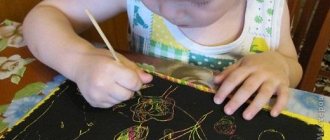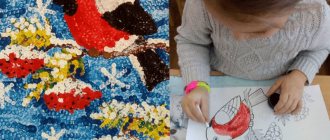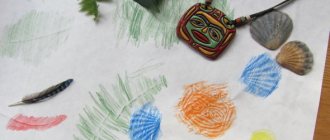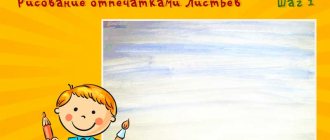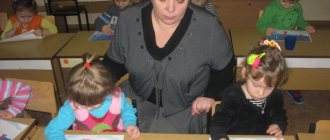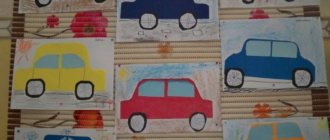Drawing for a child is an integral part of development. Through the drawing he shows his perception of the world around him, his mood, his dreams. The pointillism drawing technique for children is unconventional, and therefore very interesting to learn. The main idea is to obtain a complete image from separate points. In kindergarten, different materials are used to study pointillism - stamps, plasticine and others. We suggest mastering the method using cotton swabs and paints.
Description of the technique
Pointillism comes from the French Pointillisme, which literally means “point” (from point - dot). The technique came to us from France, where it was first used by Georges Seurat, a post-impressionist artist and founder of neo-impressionism. Thanks to the successful combination of colors, his painting “Sunday Afternoon on the Island of La Grande Jatte” became especially famous. The second striking example of pointillism is the work of Paul Signac “Harbor in Marseille”.
The peculiarity of the paintings is that they are made with separate strokes. The colors do not mix, but the eye perceives the image as a single whole. It is important to note that strokes do not always have a regular, round shape. These can be oblong lines, dots, rectangles, etc.
The use of non-traditional techniques in the art of preschool children - drawing using the “poke” method
“The origins of children’s abilities and talents are at their fingertips. From the fingers, figuratively speaking, come the finest threads - streams that feed the source of creative thought. In other words, the more skill in a child’s hand, the smarter the child.” V.A. Sukhomlinsky
Visual activities are of great importance for the development and upbringing of children. The great and multifaceted influence of art on human life and health is known.
The psychotherapeutic developmental possibilities of art lie in their very nature. Perhaps art was created in order not only to bring aesthetic joy to a person, but also to help preserve and protect him from everything that prevents him from existing normally. Drawing becomes a child’s favorite activity for a long time. It, like a game, compensates for the children’s little rights among adults.
Drawing brings pleasure to the little author and, at the same time, it strengthens the feeling of one’s strength and self-awareness. Drawing, modeling, appliqué, and manual activities are an effective means of preparing children for school, because The child develops fine motor skills and coordination of hand movements, attention, memory, imaginative ideas and imagination. Playful and visual activities are the most effective means of perception and development of speech. “...by forming and nurturing drawing skills, we are engaged in the correction of speech defects,” asserted U.V. Ulienkova.
Visual activities are of great importance in the education and social adaptation of children with developmental problems. All children draw because this is required by the persistent desire to experience and express their impressions of life, to give aesthetic and moral assessments of the environment, to express their joy at new skills, but subsequently very few take up drawing. This means that in preschool age, drawing should not be an end in itself, but a means of understanding the world around us.
Learning to draw in preschool age involves solving two interrelated problems:
- firstly, it is necessary to awaken in children emotional responsiveness to the world around them, their native nature, and the events of our lives;
- secondly, it is necessary to develop their visual skills and abilities.
Of course, for a child with developmental disabilities, activities aimed at developing his cognitive activity are even more important than for a normally developing peer. Children develop correct technical skills and abilities gradually, from lesson to lesson. As a result of a thoughtful process of learning to draw, children master the correct methods not through dry exercises, but by solving a variety of visual problems that are interesting to them.
The technical side of visual activity is subordinated to the task of creating an expressive image in a drawing. It is this goal that determines the choice of a particular material for drawing. When thinking through a lesson, I select the material in which the image of the object can be particularly expressive, interesting, beautiful, and will give children aesthetic pleasure. But this will be possible only if they well master the visual and expressive capabilities of each material.
For drawing, you can imagine various materials: simple and colored pencils, watercolors and gouache paints, wax crayons, felt-tip pens, pastels, charcoal, sanguine. In the practice of teaching children visual arts using a variety of materials, I was convinced that children like novelty. Gradually, as children master the skills of working with various materials, I try to lead them to a conscious choice of material to create their image.
A very important point here is that the child shows independence and gets the opportunity to draw with the material that he likes best. When at the end of the lesson the child sees his drawing among other works, he will notice the variety of technical solutions to the images. Then in the next lesson his choice may be different. The child must feel the possibility of choice. This contributes to the development of his creativity. It is very important that mastering technical skills and abilities allows children to depict the world in all its diversity.
In my work for several years I have been widely using various types of non-traditional drawing techniques, because... They give the baby the opportunity to “feel” the multi-colored image of an object. Non-traditional drawing techniques allow the little artist, moving away from the subject image, to express his feelings and emotions in a drawing, give freedom, instill confidence in his abilities, promote the development of fine motor skills of the hands and tactile perception; spatial orientation on a sheet of paper, development of the eye and visual perception; attention and perseverance; visual skills and abilities, observation, aesthetic perception.
Modern research proves that non-traditional image techniques help reduce the arousal of emotionally disinhibited children. At the same time, as a rule, overly active people need ample space to develop their activities. The bottom line is that attention is scattered and extremely unstable. In the process of “playing the artist,” the area of activity narrows and the amplitude of movements decreases. Large and imprecise movements gradually become more subtle and precise; the circle of attention narrows and focuses on a small area.
Observations show: the nature of the plot of the drawing in such children gradually becomes less aggressive in content and more juicy, bright and pure in color. This is on the one hand, and on the other hand, the image contributes to the development of both cognitive activity and creative activity. At the same time, mental processes and the personal sphere as a whole are corrected. By acquiring appropriate experience in drawing in an unconventional technique, the child thereby overcomes fear. Further creativity will only bring him pleasure, even from working with a brush and paints. Then you can easily move on to learning traditional drawing techniques again.
There are a great many non-traditional artistic techniques:
- imprint (cork, foam rubber, potato stamps, eraser, leaves, etc.);
- watercolor + wax crayons, candle;
- black and white and color scratch paper;
- blotography with a tube and a thread;
- spray;
- plasticineography;
- poke (with a hard brush, semi-dry);
- watercolor crayons, sanguine;
- landscape monotype;
- drawing with multi-colored foam, cardboard;
- batik;
- isothread
Having become acquainted with these techniques, I chose the most interesting and accessible for the children in my group: drawing with cotton swabs, finger drawing, palm drawing, stroke drawing, sand drawing, blotography, painting small pebbles, drawing using the “poke method”, isothread. Next, I will give a description of two non-traditional isotechniques I use - the “poke method” and the “iso-thread” method.
Drawing using the “poke method”
I believe that the advantage of drawing with the “poke method” is that it:
- Gives children the opportunity to experience the multi-colored image of objects, which is undoubtedly important for their most complete perception of the world around them.
- Helps to form an emotionally positive attitude towards the drawing process itself (even excitable children calmed down from the rhythm of drawing, they had a feeling of satisfaction from their work); promotes more effective development of imagination and perception, and consequently cognitive abilities.
- Drawings created by children using the poking method turn out to be aesthetically pleasing and understandable both to the child himself and to those around him.
- During the lesson, additional time was freed up, which I tried to use for an educational story about the depicted objects and plots, as well as for active and didactic games.
The “poke method” does not require children to professionally depict thin lines that carry an important artistic meaning (which our children do not always succeed in). It is enough to know and be able to draw geometric shapes in different combinations, and not necessarily in the correct shape or only in straight lines. In the process of painting with pokes, these inaccuracies do not affect the perception of the drawing, and the drawn objects turn out to be closer to real ones.
The drawing technique for children at the initial stage was as follows: in advance, on the child’s sheet of paper, I drew the outline of an object with a simple pencil. Children first examined and traced the outline of a given object, naming its parts out loud. This was followed by an exercise - warming up with a brush (without paint). We started drawing with pokes along the contour line (if necessary, I drew with the child’s hand). Then the children independently painted the surface inside the outline using arbitrary pokes. The remaining necessary details (eyes, nose, mustache, etc.) were completed with felt-tip pens or colored pencils (in the first drawings, with a little help from an adult). We definitely discussed: Who is this? What is this? What is he doing? What are they doing with him? Why? (Drawing a cat - why are the ears sharp? What are the paws? - soft). etc.
This is how the child learns and, by drawing, consolidates knowledge. Older children independently drew the outlines of objects with a simple pencil or directly with a brush, using geometric shapes in different combinations. The children liked to draw this way; they easily learned this method. Such drawing at the same time exercises the hand and leads to confidence in movements, to greater smoothness and ease of them, to the subordination of the drawing to visual control. Therefore, it is subsequently easier for children to master other methods of drawing.
I always tried to accompany the drawing process with the use of cognitive techniques that awaken children’s interest in the topic of drawing (riddles, poems, fairy tales, musical tales, listening to audio tapes with recordings of nature sounds, stories, conversations...) and pauses (physical education minutes, games). occupational safety rules; introduced children to the basic basics of drawing.
She instilled the ability to use knowledge previously acquired in other types of visual activities (drawing, appliqué). Introduced the basics of general and special composition. Thus, the “poke” method is easy to use and can easily be used by educators in classes with both children with special needs and healthy preschoolers.
How to draw with children?
It’s good to start introducing pointillism to children with a short presentation of paintings made in this technique.
To arouse interest, you can start the lesson with a story about how, in skillful hands, even a simple point comes to life. At the end of the theoretical part, an example of a picture to be drawn should be shown.
When choosing an image, you need to take into account age characteristics:
- In the middle and junior groups of kindergarten (4–5 years old), children are provided with blanks with an outline for drawing using the pointillism technique. For example, coloring pages with animals (chicken, fish) or toys. Images should be as simple as possible. There is no need to use a lot of paints at once. For the first lesson, you can limit yourself to one color.
- In the older group (6–7 years old), children can independently draw an object on a given topic. First, an outline is drawn with a cotton swab, and then the middle is filled with the selected color. At this age, it is recommended to use several colors.
Materials and drawing rules
Drawing with cotton swabs is a relatively clean technique. There is no need to cover the tables with oilcloth.
Prepare materials:
- paper, cardboard (can be colored) or coloring;
- paints (watercolor, gouache);
- cotton swabs - according to the number of colors used;
- a glass of water.
Drawing rules:
- Hold the stick perpendicular to the paper.
- After dipping the cotton wool into the paint of the desired color, leave prints with short pokes.
- Fill in the outline first and gradually move from the edges to the center.
- Use a separate cotton swab for each color.
Drawing a winter landscape
In winter, learning to draw with cotton swabs will come in handy. Using the pointillism technique, you can easily and quickly depict snowflakes. For winter themes, colored cardboard is used as a basis - blue, black or gray. White color is clearly visible against a dark background.
Examples of children's drawings on the theme “winter fantasy”:
Children's work always turns out different, even if only one sample was taken. The drawing reflects the individual vision, character, knowledge, skills and abilities of the little artist.
When children master drawing with cotton swabs, it will be useful to conduct a lesson using several non-traditional techniques at once. The purpose of the lesson is to consolidate knowledge and teach the child to use available objects to obtain the desired texture and realize a creative idea.
Experienced teachers and doctors believe that drawing plays an important role in the development of children. Exercises have a positive effect on the central nervous system. They promote the development of speech skills and fine motor skills. Non-traditional techniques are notable for the fact that they make it possible to introduce very young children to art, since they do not require skillful brush strokes or pencil strokes. Mastering the technique of drawing with a cotton swab is not difficult. During the lesson, each child will be able to feel like an artist creating a work of art.
Pointillism. Drawing technique for children with cotton swabs
Pointillism.
An unconventional technique of painting with cotton swabs. Author : Lavrenko Tamara Mikhailovna, additional education teacher, Municipal Budgetary Educational Institution of Preschool Youth and Youth Center, Yeisk, Krasnodar Territory Description: the material can be useful to teachers of preschool and additional education, teachers, children and their parents. Purpose: use in drawing classes, in circle work, interior decoration, as practical work when getting acquainted with non-traditional drawing techniques. Goal: to develop fantasy and imagination in children through an unconventional drawing technique: with cotton swabs. Objectives: - to introduce the movement of fine art “pointillism”; — expand knowledge through familiarity with non-traditional drawing techniques, as a means of developing children’s interest in fine art. — teach practical skills in the field of visual arts using cotton swabs; — create conditions for self-realization and stimulation of the growth of children’s creative potential. *** What is unconventional drawing? This is creativity that does not adhere to the classical traditions of artistic representation. Drawing in non-traditional techniques is free from the canons of academic drawing, it is more simplified and accessible to children’s perception and therefore delights, surprises and develops children’s imagination. Unconventional painting uses a variety of unusual materials. You can depict what you want, how you want and with what you want.
Pictures made using any or several methods at once turn out unusual, interesting and fabulous. One of the types of non-traditional drawing techniques is drawing with cotton swabs. It turns out that cotton swabs can be used not only for their intended purpose. With their help, you can also draw, and develop children in the process of creativity. This method is very simple. You just need to dip a cotton swab in gouache and make an impression on paper. You can come up with any pattern and use the “poke” method to create an unusually beautiful picture. Children love this drawing method very much. Drawing with cotton swabs can be called a type of pointillism. Pointillism is a unique movement in painting, which translated from French means “painting with dots.” Many artists painted paintings of this kind. For example, paintings by Georges Seurat are recognized as masterpieces. He is considered the founder of this technique. The 19th and 20th centuries were rich in new trends in art. Artists experimented a lot, looking for new expressive forms and possibilities. And as a result of such searches, pointillism appeared in painting. Georges-Pierre Seurat is the founder of neo-impressionism, a French artist who introduced into painting the method of creating pictures by applying many adjacent dots of pure contrasting colors to the canvas (pointillism). Neo-Impressionism influenced many famous painters of the time. Eiffel Tower.1889
Seine at La Grande Jatte, spring 1888
Powdering girl" 1889-90
Drawing with cotton swabs is a very unusual and interesting technique. It is important that when creating a picture, paints should not be mixed with each other. In this case, the distance from one point to another can be large, or, on the contrary, you can place the points close to each other. Preschool children learn to draw with cotton swabs:
Children of primary school age can be taught to draw with cotton swabs, especially since it is still difficult for them to draw with a brush using the pointillism technique. But a cotton swab is more convenient and simpler, in addition, it does not need to be washed.
However, despite its apparent simplicity, it is also a lot of work.
When drawing using the pointillism technique, coordination of movements, accuracy and precision are trained, and fine motor skills of the hands are developed.
Drawings supplemented with dots look very impressive, for example, ready-made landscapes painted in watercolor or gouache, where snow, rain or parts of plants, animals and birds are painted on the already dried paint layer using cotton swabs.
Landscapes depicting rounded shapes: clouds, forests, trees are good for using the pointillism technique.
The technique of drawing with dots is unusual, interesting and quite simple. I recommend this technique when drawing flowers: lilacs, dandelions.
Sometimes I use templates to perform this technique. Drawing using the pointillism technique provides a wide opportunity to create real children's “masterpieces.” Even if children work according to a template, the result is different for everyone, because each child has his own individual perception, his own characteristics of character and handwriting. These are the interesting things that come out of mastering this technique.
Works of children 7 - 8 years old.
We recommend watching:
Unconventional drawing technique pointillism Pointillism is a drawing technique for children with cotton swabs. Master class with step-by-step photos for children Drawing “Sea Turtle” for children 7-8 years old step by step with photos Drawing “Carnival “Fiesta Patronal”. Portrait of a conquistador” step by step with photos. Primary School
Similar articles:
Pointillism for children. Master Class
Drawing on the theme Autumn in the preparatory group
Non-traditional drawing techniques for preschoolers. Leaves imprint
An unconventional drawing technique using a print for preschoolers. Master Class
